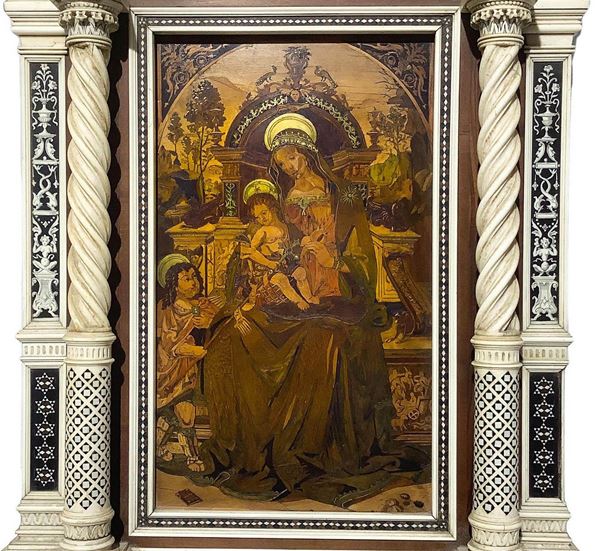Alessandro Monteneri (Perugia, 1832 - 1920)
Small newsstand / altarpiece in wood, ivory and mother of pearl, 1879
Inside a wooden mosaic on an axonometric scale in wood depicting the Madonna enthroned with child and San Giovannino. Signed on the back Alessandro Monteneri of Perugia and dated 1879.
We draw inspiration from the previous expertise of Paolo Cesari, expert of the court of Ferrara , C.T.U. of the Public Prosecutor's Office of Bologna, member of the European Meeting of Art and Antiques Experts.
Alessandro Monteneri (Perugia 1832-1920), a well-known Perugian inlayer, achieved very important results, from a technical and executive point of view, in the years in which the historicist Neo-Renaissance style, especially in Italy, met extraordinary vogue and saw protagonists, at national exhibitions and international, a large group of great names: the Gatti of Faenza, the Falcini brothers of Florence, the Gargiullos of Naples, the Lancetti of Siena.
Pa he participated in numerous exhibitions, including those in Florence (1861), London (1862), Vienna (1873) and Milan (1881) and worked at the Quirinale, in the Vatican and for numerous churches in Loreto, Mantua, Perugia and Urbino. & nbsp;
In 1928 he created the stalls in the Basilica of San Paolo fuori le mura in Rome inlaid by the choir, based on drawings by Calderini. & nbsp;
Also esteemed skilled restorer, Monteneri reached its artistic peak with the creation of the "Stipo for the Crown of Italy", defined as his masterpiece, commissioned by the Municipality of Per ugia as a gift to be offered to Vittorio Emanuele II, now kept in Florence, at Palazzo Pitti.
On the occasion of the Milan Exhibition it was written about him:" He is an artist who emerges from the crowd for his value, for the method used in his works which differs from that of other congeners because the inlay he uses is not a veneer, a coating with a surface coloring, but rather an infinite quantity of pieces of wood sawn divergently and then, vertically together, assembled with admirable skill and patience. Monteneri, with his system that brought him honors and prizes at the exhibitions in Florence, London, Dublin and Paris ..., in addition to carrying out the works he himself designed, reproduced with rare perfection paintings by great painters, in which the fusion of tinte imitates to the point of deceiving the work of the brush, thus giving art new masterpieces of wooden mosaic ... ".
















